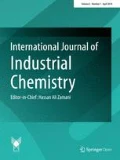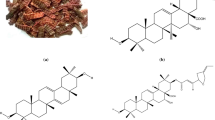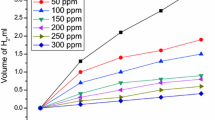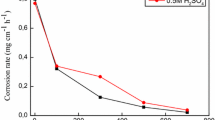Abstract
Low-carbon steel (LCS) in 0.5 M sulphuric acid is used to check the corrosion resistance performance of Pfaffia paniculata (P. paniculata) root extract. Notably, P. paniculata showed 91% corrosion resistance efficiency at 600 mg/L concentration. The adsorption of this inhibitor follows the Langmuir adsorption isotherm suggesting its monolayer formation on the LCS surface. The potentiodynamic polarization experiments indicated its nature as mixed adsorption behaviour. P. paniculata shows 88.34%, 90.16%, and 91.59% inhibition efficiency by weight loss, polarization, and EIS technique respectively. The scanning electron microscopy and atomic force microscopy techniques were used for the verification of protective layer on the LCS surface. The protective film formation study was checked using the UV–Vis. spectroscopy. Computational investigations were consolidated as a valuable report. All acquired outcomes confirmed that P. paniculata root extract can develop an efficient protective layer and resist the corrosion procedure.








Similar content being viewed by others
References
Koch G, Varney J, Thompson N, Moghissi O, Gould M, Prayer J (2013) International measures of prevention, application, and economics of corrosion technologies study. NACE 1:1–226
Salarvand Z, Amirnasr M, Talebian M, Raeissi K, Meghdadi S (2012) Enhanced corrosion resistance of mild steel in 1M HCl solution by trace amount of 2-phenyl-benzothiazole derivatives: experimental, quantum chemical calculations and molecular dynamics (MD) simulation studies. Corros Sci 114:133–145
Deng S, Li X (2012) Inhibition by Ginkgo leaves extract of the corrosion of steel in HCl and H2SO4 solutions. Corros Sci 55:407–415
Rose K, Kim BS, Rajagopal K, Arumugam S, Devarayan K (2016) Surface protection of steel in acid medium by Tabernaemontana divaricata extract: physicochemical evidence for adsorption of inhibitor. J Mol Liq 214:111–116
Garai S, Garai S, Jaisankar P, Singh JK, Elango A (2012) A comprehensive study on crude methanolic extract of Artemisia pallens (Asteraceae) and its active component as effective corrosion inhibitors of mild steel in acid solution. Corros Sci 60:193–204
Patel N, Rawat A, Jauhari S, Mehta G (2010) Inhibitive action on Bridelia restusa leaves extract on corrosion of mild steel in acidic media. Eur J Chem 1:129–133
Ibrahim T, Alayan H, Al-Mowaqet Y (2012) The effect of Thyme leaves extract on corrosion of mild steel in HCl. Prog Org Coatings 75:456–462
Kalaiselvi P, Chellammal S, Palanichamy S, Subramanian G (2010) Artemisia pallens as corrosion inhibitor for mild steel in HCl medium. Mater Chem Phys 120:643–648
Oguzie EE, Chidiebere MA, Oguzie KL, Adindu CB, Momoh-Yahaya H (2014) BioLC-MS extracts for materials protection: corrosion inhibition of mild steel in acidic media by Terminalia chebula extracts. Chem Eng Commun 201:790–803
Li X, Deng S (2012) Inhibition effect of Dendrocalamus brandisii leaves extract on aluminum in HCl, H3PO4 solutions. Corros Sci 65:299–308
Ituen E, Akaranta O, James A, Sun S (2017) Green and sustainable local biomaterials for oilfield chemicals: Griffonia simplicifolia extract as steel corrosion inhibitor in hydrochloric acid. Sustain Mater Technol 11:12–18
Hassan KH, Khadom AA, Kurshed NH (2016) Citrus aurantium leaves extracts as a sustainable corrosion inhibitor of mild steel in sulfuric acid. S Afr J Chem Eng 22:1–5
Jokar M, Farahani TS, Ramezanzadeh B (2016) Electrochemical and surface characterizations of Morus alba pendula leaves extract (MAPLE) as a green corrosion inhibitor for steel in 1 M HCl. J Taiwan Inst Chem Eng 63:436–452
Bagga MK, Gadi R, Yadav OS, Kumar R, Chopra R, Singh G (2016) Investigation of phytochemical components and corrosion inhibition property of Ficus racemosa stem extract on mild steel in H2SO4 medium. J Environ Chem Eng 4:4699–4707
Umoren SA, Eduok UM, Solomon MM, Udoh AP (2016) Corrosion inhibition by leaves and stem extracts of Sida acuta for mild steel in 1 M H2SO4 solutions investigated by chemical and spectroscopic techniques. Arab J Chem 9:S209–S224
Prabakaran M, Kim SH, Hemapriya V, Chung IM (2016) Evaluation of polyphenol composition and anti-corrosion properties of Cryptostegia grandiflora plant extract on mild steel in acidic medium. J Ind Eng Chem 37:47–56
Alaneme KK, Olusegun JS, Alo AW (2016) Corrosion inhibitory properties of elephant grass (Pennisetum purpureum) extract: effect on mild steel corrosion in 1 M HCl solution. Alexandria Eng J 55:1069–1076
Anupama KK, Ramya K, Joseph A (2016) Electrochemical and computational aspects of surface interaction and corrosion inhibition of mild steel in hydrochloric acid by Phyllanthus amarus leaf extract (PAE). J Mol Liq 216:146–155
Alaneme KK, Olusegun SJ, Adelowo OT (2016) Corrosion inhibition and adsorption mechanism studies of Hunteria umbellata seed husk extracts on mild steel immersed in acidic solutions. Alexandria Eng J 55:673–681
Nakai S, Takagi N, Miichi H, Hayashi S, Nishimoto N, Takemoto T, Kizu H (1984) Pfaffosides, nortriterpenoid saponins, from Pfaffia paniculata. Phytochemistry 23:1703–1705
Gosmann G et al (2003) Botanical (morphological, micrographic), chemical and pharmacological characteristics of Pfaffia species (Amaranthaceae) native to South Brazil. Revista Brasileira de Ciências Farmacêuticas 39:141–147
Ji G, Anjum S, Sundaram S, Prakash R (2015) Musa paradisica peel extract as green corrosion inhibitor for mild steel in HCl solution. Corros Sci 90:107–117
Haldhar R, Prasad D, Saxena A, Singh P (2018) Valeriana wallichi root extract as a green and sustainable corrosion inhibitor for mild steel in acidic environments: experimental and theoretical study. Mater Chem Front 2:1225–1237
Haldhar R, Prasad D, Saxena A (2018a) Myristica fragrans extract as an eco-friendly corrosion inhibitor for mild steel in 0.5 M H2SO4. J Environ Chem Eng 6:2290–2301
Saxena A, Prasad D, Haldhar R (2018a) Investigation of corrosion inhibition effect and adsorption activities of Cuscuta reflexa extract for mild steel in 0.5 M H2SO4. Bioelectrochemistry 124:156–164
Saxena A, Prasad D, Haldhar R (2018b) Investigation of corrosion inhibition effect and adsorption activities of Achyranthes aspera extract for mild steel in 0.5 M H2SO4. J Fail Anal Prevent. 18:957–968
Bhardwaj N, Prasad D, Haldhar R (2018) Study of the Aegle marmelos as a green corrosion inhibitor for mild steel in acidic medium: experimenta and theoretical approach. J Bio-and Tribo-Corros 4:1–10
Haldhar R, Prasad D (2020) Corrosion resistance and surface protective performance of waste material of Eucalyptus globulus for low carbon steel. J Bio- Tribo-Corros 6:1–13
Saxena A, Prasad D, Haldhar R (2018c) Use of Asparagus racemosus extract as green corrosion inhibitor for mild steel in 0.5 M H2SO4. J Mater Sci 53:8523–8535
El-Etre AY, Abdallah M, El-Tantawy ZE (2005) Corrosion inhibition of some metals using Lawsonia extract. Corros Sci 47:385–395
Kumar R, Yadav OS, Singh G (2017) Electrochemical and surface characterization of a new eco-friendly corrosion inhibitor for mild steel in acidic media : a cumulative study. J Mol Liq 237:413–427
Haddadi SA, Alibakhshi E, Bahlakeh G, Ramezanzadeh B, Mahdavian M (2019) A detailed atomic level computational and electrochemical exploration of the Juglans regia green fruit shell extract as a sustainable and highly efficient green corrosion inhibitor for mild steel in 3.5 wt% NaCl solution. J Mol Liq 284:682–699
Joseph OO, Fayomi OSI, Joseph OO, Adenigba OA (2017) Effect of Lecaniodiscus cupanioides extract in corrosion inhibition of normalized and annealed mild steels in 0.5 M HCl. Energ Proc. 119:845–851
Haldhar R, Prasad D, Saxena A, Kumar A (2018) Experimental and theoretical studies of Ficus religiosa as green corrosion inhibitor for mild steel in 0.5 M H2SO4 solution. Sust Chem Pharm 9:95–105
Alibakhshi E, Ramezanzadeh M, Haddadi SA, Bahlakeh G, Ramezanzadeh B, Mahdavian M (2019) Persian Liquorice extract as a highly efficient sustainable corrosion inhibitor for mild steel in sodium chloride solution. J Clean Prod 210:660–672
Haldhar R, Prasad D, Saxena A, Kaur A (2018) Corrosion resistance of mild steel in 0.5 M H2SO4 solution by plant extract of Alkana tinctoria: experimental and theoretical studies. Eur Phys J Plus 133:18
Haldhar R, Prasad D, Saxena A (2018b) Armoracia rusticana as sustainable and eco-friendly corrosion inhibitor for mild steel in 0.5 M sulphuric acid: experimental and theoretical investigations. J Environ Chem Eng 6:5230–5238
Samiee R, Ramezanzadeh B, Mahdavian M, Alibakhshi E, Bahlakeh G (2019) Graphene oxide nano-sheets loading with praseodymium cations: adsorption-desorption study, quantum mechanics calculations and dual active-barrier effect for smart coatings fabrication. J Ind Eng Chem 78:143–154
Haldhar R, Prasad D, Bhardwaj N (2019) Extraction and experimental studies of Citrus aurantifolia as an economical and green corrosion inhibitor for mild steel in acidic media. J Ades Sci Tehnol 33:1169–1183
Alibakhshi E, Ramezanzadeh M, Bahlakeh G, Ramezanzadeh B, Mahdavian M, Motamedi M (2018) Glycyrrhiza glabra leaves extract as a green corrosion inhibitor for mild steel in 1 M hydrochloric acid solution: experimental, molecular dynamics, Monte Carlo and quantum mechanics study. J Mol Liq 255:185–198
Dehghani A, Bahlaked G, Ramezanzadeh B, Ramezanzadeh M (2020) Experimental complemented with microscopic (electronic/atomic)-level modelling explorations of Laurus nobilis extract as green inhibitor for carbon steel in acidic solution. J Ind Eng Chem 84:52–71
Dehghani A, Bahlakeh G, Ramezanzadeh B, Ramezanzadeh M (2019) Detailed macro-/micro-scale exploration of the excellent active corrosion inhibition of a novel environmentally friendly green inhibitor for carbon steel in acidic environments. J Taiwan Inst Chem E 100:239–261
Keramatinia M, Ramezanzadeh B, Mahdavian M (2019) Green production of bioactive components from herbal origins through one-pot oxidation/polymerization reactions and application as a corrosion inhibitor for mild steel in HCl solution. J Taiwan Inst Chem E 105:134–149
Dehghani A, Bahlakeh G, Ramezanzadeh B (2019) Green Eucalyptus leaf extract: a potent source of bio-active corrosion inhibitors for mild steel. Bioelectrochemistry 130:107339
Acknowledgements
The authors pay grateful thanks to Dr. Gurmeet Singh, Ex-HOD of Department of Chemistry at University of Delhi, Delhi, India, for offering the laboratory resource for impedance workstation.
Author information
Authors and Affiliations
Corresponding author
Ethics declarations
Conflict of interest
The author declares that there is no conflict of interest.
Additional information
Publisher's Note
Springer Nature remains neutral with regard to jurisdictional claims in published maps and institutional affiliations.
Supplementary Information
Below is the link to the electronic supplementary material.
Rights and permissions
About this article
Cite this article
Haldhar, R., Prasad, D. & Saharan, H. Performance of Pfaffia paniculata extract towards corrosion mitigation of low-carbon steel in an acidic environment. Int J Ind Chem 11 (Suppl 1), 1–12 (2020). https://doi.org/10.1007/s40090-020-00222-0
Received:
Accepted:
Published:
Issue Date:
DOI: https://doi.org/10.1007/s40090-020-00222-0




